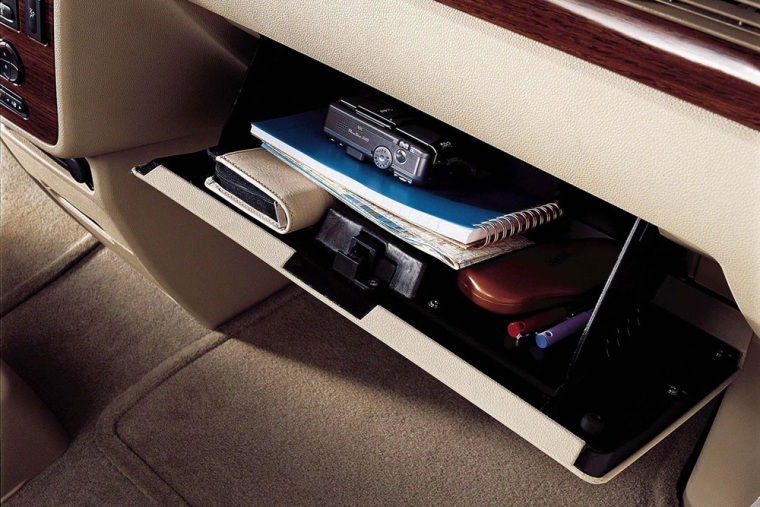In the age of global position systems and sonar proximity sensors, one feature is still pretty much the same as it has been since automobiles were called "horseless carriages" — the glove compartment.
The makers of Packard's earliest horseless carriages probably didn't know, or even care, but according to auto historians, they basically invented the glove compartment. Turn-of-the-century tire-kickers considering a 1900 Packard were promised soft and stylish storage for their traveling accoutrements. "The body of the carriage shows the best possible coachwork and upholstering," boasted the original sales literature from the Packard dealership. "Instead of a leather dash, there is a boot or box forming part of the body. In this is ample space for parcels, waterproofs, etc."
The glove compartment, or the glove box, as it's often called, is perhaps one of the most misrepresented parts of the automobile, being that gloves have always been only a small part of its inventory. Over the past century, these mini car closets have been used to store handbags, driving goggles, six packs of beer, sunglasses, keys to other cars, cell phones, and even small dogs.
Today, gloves barely register as glove compartment occupants.
So why call it a glove box, and not "driving goggle box" or "small dog box"?
"You couldn't keep your coat in the car. But if you were only using gloves to drive, you could keep a pair of gloves in the car, so people started calling that box the glove compartment," says Leslie Kendall, curator of the Petersen Museum, a Los Angeles-based automotive museum that links automotive culture to the development and growth of Los Angeles.
Because early automobiles were mostly topless, driving was an outdoor pursuit. That meant braving the elements, even in sunny Southern California. "Even if you weren't racing cars, you needed to have hats and gloves and goggles on, just to keep the dust off of your face," Kendall says.
The National Automobile Museum in Reno, Nev., says the 1900 Packard-style glove compartment was quickly adopted by other early automakers. The 1902 Oldsmobile Curved Dash Roundabout had a leather satchel nestled into its dash that was held closed with four buckles. The 1903 Duryea had a box built into the dash, opening on top instead of in front with a decorative iron rail on the lid. Other automakers included baskets, hampers, and trunks for storage, and by the 1930s, glove boxes had become standard equipment.
But by that time, the boxes were already being used to store a plethora of other objects.
"There's a 1933 or '34 film that GM did, that showed people who had a small dog in the glove compartment," says Greg Wallace, an automotive historian with the General Motors Heritage Center, in Warren, Mich.
Wallace says that driving a car in the old days was a bit like driving a snowmobile — "cold and dirty" — but that didn't stop some automakers from selling storage as style. "Some Cadillacs came with rails to store robes that people wore to keep warm," he says, adding that these "blankets" were part of Cadillacs as late as the 1950s. "They sold the robes as an accessory with people's initials monogrammed on them."
As automobiles became extensions of drivers' personas during the post-World War II boom and beyond, glove compartments and their contents were seen to mirror the personality of the car's owner. "If you kept something expensive in there, people would think you were special," Kendall says. "It's part of the first impression. It's the car and whatever is associated with the car. And once you go inside, it becomes a little more personal."
"In L.A., for example, you 'put on' a car as much as you get into one," Kendall says. "It's almost like carrying a wallet or a purse with you: you put things into a car that are you."
So as time went on, drivers' gloves and goggles gave way to lipstick, make-up compacts, sunglasses, and handbags. "Some glove compartments even had mirrors in them, before sun visors came along," Kendall says.
Today's cars still have glove compartments, and their use is just as eclectic ever. Research shows that Americans use the cubbies to store everything from insurance records to packets of fast-food condiments.
And automakers are still touting convenient storage for drivers and passengers, although sometimes in surprising new ways.
Dodge is expanding the glove compartments in its 2008 Avenger sedans to include the Chill Zone, a refrigerated beverage storage bin. Housed in the passenger-side upper instrument panel, the bin can hold as many as four 12-ounce beverage cans.
A phone research study commissioned by Dodge and conducted by Ipsos Insight found that 88 percent of consumers would keep cold water or juice in their car, if such a refrigerated compartment was available.
"We put two and two together," says Mike Accavitti, director of Dodge brand and SRT marketing and communications, who says Dodge's history with the glove compartment dates to models as early as 1915. "Wouldn't it be great to not have to stop for a drink while on a road trip, but to be able to have a means to keep the drinks cool? That's why we rolled out the Chill Zone."
Nissan is also evolving the glove compartment on some of its models, particularly those targeted at younger drivers. The Rogue crossover utility vehicle and Sentra sedan both have glove compartments deep enough to swallow laptop computers. This provision is a reaction to drivers who often take laptops on the road, but then want a place to keep them secure and out of sight when they leave the car.
The research Dodge commissioned from Ipsos polled drivers on how they use their glove compartments. Beyond the 26 percent who don't use them at all, Dodge found a wide array of uses, none of which have anything to do with storing driving gloves, goggles, or small dogs.
